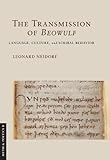The Transmission of "Beowulf" : Language, Culture, and Scribal Behavior / Leonard Neidorf.
Material type: TextSeries: Myth and Poetics IIPublisher: Ithaca, NY : Cornell University Press, [2017]Copyright date: ©2017Description: 1 online resource (224 p.)Content type:
TextSeries: Myth and Poetics IIPublisher: Ithaca, NY : Cornell University Press, [2017]Copyright date: ©2017Description: 1 online resource (224 p.)Content type: - 9781501708282
- 9781501708282
- Epic poetry, English (Old) -- Criticism, Textual
- Language and culture -- History -- To 1500 -- England
- Language and culture -- England -- History -- To 1500
- Transmission of texts -- History -- To 1500 -- England
- Transmission of texts -- England -- History -- To 1500
- Literary Studies
- Medieval & Renaissance Studies
- Poetry & Criticism
- LITERARY CRITICISM / Ancient & Classical
- 829.3 23
- PR1586
- PR1586 .N45 2018
- online - DeGruyter
- Issued also in print.
| Item type | Current library | Call number | URL | Status | Notes | Barcode | |
|---|---|---|---|---|---|---|---|
 eBook
eBook
|
Biblioteca "Angelicum" Pont. Univ. S.Tommaso d'Aquino Nuvola online | online - DeGruyter (Browse shelf(Opens below)) | Online access | Not for loan (Accesso limitato) | Accesso per gli utenti autorizzati / Access for authorized users | (dgr)9781501708282 |
Frontmatter -- CONTENTS -- ILLUSTRATIONS -- SERIES FOREWORD -- PREFACE -- ACKNOWLEDGMENTS -- ABBREVIATIONS -- 1. Introduction -- 2. Language History -- 3. Cultural Change -- 4. Scribal Behavior -- 5. Conclusion -- Appendix -- GLOSSARY OF TERMS -- BIBLIOGRAPHY -- INDEX OF VERSES -- INDEX OF SUBJECTS
restricted access online access with authorization star
http://purl.org/coar/access_right/c_16ec
Beowulf, like The Iliad and The Odyssey, is a foundational work of Western literature that originated in mysterious circumstances. In The Transmission of "Beowulf," Leonard Neidorf addresses philological questions that are fundamental to the study of the poem. Is Beowulf the product of unitary or composite authorship? How substantially did scribes alter the text during its transmission, and how much time elapsed between composition and preservation?Neidorf answers these questions by distinguishing linguistic and metrical regularities, which originate with the Beowulf poet, from patterns of textual corruption, which descend from copyists involved in the poem's transmission. He argues, on the basis of archaic features that pervade Beowulf and set it apart from other Old English poems, that the text preserved in the sole extant manuscript (ca. 1000) is essentially the work of one poet who composed it circa 700. Of course, during the poem's written transmission, several hundred scribal errors crept into its text. These errors are interpreted in the central chapters of the book as valuable evidence for language history, cultural change, and scribal practice. Neidorf's analysis reveals that the scribes earnestly attempted to standardize and modernize the text's orthography, but their unfamiliarity with obsolete words and ancient heroes resulted in frequent errors. The Beowulf manuscript thus emerges from his study as an indispensible witness to processes of linguistic and cultural change that took place in England between the eighth and eleventh centuries. An appendix addresses J. R. R. Tolkien's Beowulf: A Translation and Commentary, which was published in 2014. Neidorf assesses Tolkien's general views on the transmission of Beowulf and evaluates his position on various textual issues.
Issued also in print.
Mode of access: Internet via World Wide Web.
In English.
Description based on online resource; title from PDF title page (publisher's Web site, viewed 02. Mrz 2022)


